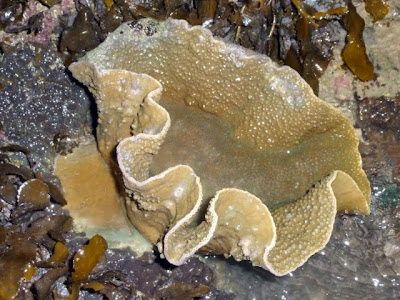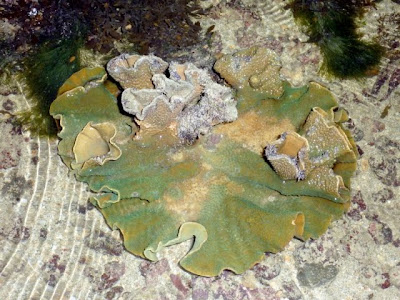It's the last morning tide trip before the lower low spring tide switches to evening. Which means no need to wake up at unearthly hours until March next year! :-)
Together with Allen, Shuyi and Joo Yong, we had a good look at Sentosa's natural shore and reef. There are 3 objectives in this trip. First is to recce the shore for future field trips with students, second is to check out the bleaching event and third is the mission to find the elusive Galloping sea star which has been sighted twice by Chay Hoon and Ron!
I would say there are about 70-80% of the corals that are unbleached. Most of the bleached corals are only partially bleached like this hard coral above. It is possible that this hard coral is recovering through zooxanthallae restoration back to the coral.
Here's another bleached Favid hard coral (Family Faviidae) that is not completely bleached. It could either be in a state of more bleaching or recovery. I think it is the latter.

Otherwise, many of the corals that I encountered this morning are unbleached and doing well on the shore.
Among the reefs and corals are also patches of Tape seagrass (Enhalus acoroides). Here you can actually also see the female flower and its petals sticking out.
Sentosa is a great shore to find various morphologies of the Disk corals (Turbinaria sp.). Here's a bright green colony that is rather flat and circular.
As for this disk coral, it looks a bit like a bowl. Haha!
And this third disk coral seems to be a mixture of the above two corals.
Most of the soft corals like the Leathery soft corals (Family Alcyoniidae) are also doing well at Sentosa.
Here is another species of leathery coral that is also unbleached.
Among all the soft corals I encountered, I only came across only a couple that looks bleached like this colony.
How about the anemones? Most are also doing great. Here is a Giant carpet anemone (Stichodactyla gigantea) with a pair of commensal Five-spot anemone shrimps (Periclimines brevicarpalis).
The Haddon's carpet anemone (Stichodactyla haddoni) at the sandier parts of the shore are also doing alright. This carpet anemone is quite interesting as it shrinks itself, thus showing its body column.
This Wriggly star anemones is very pretty. But also very shy! It will shrink at the slightest detection of movement and danger.
Here is what I would call a sponge city. Among the sponges, can you spot the two hermit crabs, small crabs, a goby as well as creeper snails?
Even within this Barrel Sponge (Rhabdastrella globostellata) is a cowrie. Haha!
More animals spotted during the trip include this Giant top shell snail (Trochus niloticus). It is called giant as this snail is much larger than the others.
I caught the action of this cute little Hairy crab (Family Pilumnidae) that is holding on to a blue sponge. Is the crab going to eat this sponge?
Finally, yes finally I managed to snap a picture of the ever so elusive Coral ghost shrimp (Glypturus sp.). This ghost shrimp indeed lives up to it's name. It always shrinks into its burrow upon detection of movement around it. I had to wait for a long time to get this fellow photographed.
As it was a predawn trip, the octopuses were very active on the shore. Many of us saw several of them during the trip.
This is another Two-spot reef octopus that is quite large and it tried to move away from me.
Another creature that is usually very hard to photograph will be this Worm-eel (Muraenichthys sp.). The worm eel is not a worm but a fish! The tail tip is bony and sharp so it can burrow quickly, both forwards and backwards! It swims by moving the body in S-shapes, rather like a sea snake.
This egg case is also named as the mermaid's purse. It is a casing that surrounds the fertilized eggs of sharks!
The top find of the day will be this Black frogfish found by Allen. It was stranded on the sand.
The frogfish has a bait or a lure at the top of the head to attract prey within striking distance. It is capable of 'sucking' small fishes into its huge mouth simply by opening it. Interesting isn't it!?
Sad to say, we didn't encounter the Galloping sea star though I tried hard to search for it. Maybe next time? That will probably be the reason for another trip to Sentosa's shore. Hahaha!
More photos of today's trip here: http://www.flickr.com/photos/koksheng/archives/date-posted/2010/09/09/
Thursday, September 9, 2010
Last morning trip at Sentosa
Subscribe to:
Post Comments (Atom)




























1 comment:
Amazing photos!
Post a Comment